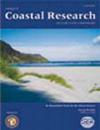Reactivation of Coastal Dunes Documented by Subsurface Imaging of the Great Dune Ridge, Lithuania
4区 地球科学
Q3 Earth and Planetary Sciences
引用次数: 32
Abstract
BUYNEVICH, I., BITINAS, A. and PUPIENIS, D., 2007. Reactivation of coastal dunes documented by subsurface imaging of the Great Dune Ridge, Lithuania. Journal of Coastal Research, SI 50 (Proceedings of the 9th International Coastal Symposium), 226 – 230. Gold Coast, Australia, ISSN 0749.0208 Large coastal and inland dunefields often consist of multiple generations defined by periods of stability and reactivation. Where earlier phases of aeolian activity are masked by subsequent deposition, continuous highresolution geophysical images help to reconstruct the history of landscape change. Ground-penetrating radar (GPR) profiles from relict Holocene dunes on the northern Curonian Spit, Lithuania reveal distinct contacts between older deposits (barrier-spit facies, older aeolian strata, paleosols) and overlying dune sands. Early stages of dune migration began prior to 6,000 years B.P. followed by several periods of stabilisation and subsequent reactivation. Parabolic and transverse dunes, some attaining heights of 40-60 m, have migrated to the east in response to westerly winds from the Baltic Sea. In several places, similar to a number of sites in Northern Europe, the upper sections of large dunes have been deflated leaving near-horizontal exposures where subsurface imaging extends the continuity of key stratigraphic horizons. Within dune sequences, oblique lateral accretion surfaces indicate the direction of earlier migration phases and exhibit distinct meso-scale geometries. In GPR images and shallow trenches, buried slipfaces have dip angles varying from 10-15o to 31-34o, the latter being similar to the angle of repose maintained by modern unvegetated dunes. A series of cores taken through sequences of stacked buried slipfaces show little visible variation in sediment properties with depth, suggesting that minor changes in texture, mineralogy and grain packing may be responsible for individual reflections in geophysical records. Occasionally, laterally extensive horizons enriched in heavy minerals produce prominent subsurface reflections and are indicative of periods of increased wind activity.立陶宛大沙丘岭地表下成像记录的沿海沙丘重新活跃情况
BUYNEVICH, I., BITINAS, A. and PUPIENIS, D., 2007.The ocean and the ocean of the ocean.The ocean and the ocean of the ocean of the ocean of the ocean of the ocean of the ocean of the ocean of the ocean of the ocean of the ocean of the ocean of the ocean of the ocean of the ocean of the ocean of the ocean of the ocean of the ocean of the ocean of the ocean of the ocean.The ocean and the ocean of the ocean of the ocean of the ocean of the ocean of the ocean of the ocean of the ocean of the ocean of the ocean of the ocean of the ocean of the ocean of the ocean of the ocean of the ocean of the ocean of the ocean of the ocean of the ocean of the ocean of the ocean of the ocean of the ocean of the ocean.当早期的风化活动被随后的沉积掩盖时,连续的高分辨率地球物理图像有助于重建景观变 化的历史。立陶宛库罗尼亚海湾北部全新世沙丘的探地雷达(GPR)剖面显示,较早的沉积物(屏障-海湾面、较早的风化层、古沉积物)与上覆沙丘沙之间存在明显的接触。沙丘迁移的早期阶段始于公元前 6,000 年之前,随后经历了几个稳定期和重新活跃期。抛物线状和横向沙丘(有些高达 40-60 米)在来自波罗的海的西风作用下向东迁移。在一些地方,与北欧的一些地点类似,大型沙丘的上部已经塌陷,留下了近乎水平的露头,在这些露头的地下成像中,关键地层的连续性得以延伸。在沙丘序列中,倾斜的横向增生面显示了早期迁移阶段的方向,并呈现出独特的中尺度几何形状。在 GPR 图像和浅沟中,埋藏的滑动面的倾角从 10-15o 到 31-34o 不等,后者与现代未植被沙丘保持的倾角相似。通过堆叠的埋藏滑动面序列采集的一系列岩芯显示,沉积物性质随深度的变化几乎不明显,这表明质地、矿物学和颗粒堆积的微小变化可能是地球物理记录中个别反射的原因。偶尔,富含重矿物的横向广泛地层会产生突出的次表层反射,表明风力活动增加的时期。
本文章由计算机程序翻译,如有差异,请以英文原文为准。
求助全文
约1分钟内获得全文
求助全文
来源期刊

Journal of Coastal Research
地学-地球科学综合
自引率
0.00%
发文量
87
审稿时长
3-8 weeks
期刊介绍:
The Journal of Coastal Research (JCR) is one of the leading international journals for coastal studies and processes, and is published bi-monthly by the Coastal Education & Research Foundation [CERF]. By covering the entire field of coastal research, the JCR encompasses all subjects relevant to natural and engineered environments (freshwater, brackish, or marine) and the protection/management of their resources in the vicinity of coastlines of the world. Even though the journal broadly focuses on immediate shoreline zones, the JCR also embraces those coastal environments that either reach some indefinite distance inland or that extend seaward beyond the outer margins of the sublittoral (neritic) zone. The JCR disseminates accurate information to both the public and research specialists around the world on all aspects of coastal issues in an effort to maintain or improve the quality of our planet''s shoreline resources.
 求助内容:
求助内容: 应助结果提醒方式:
应助结果提醒方式:


